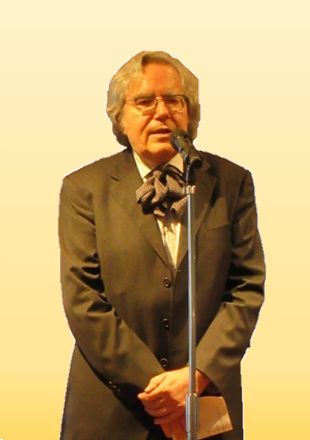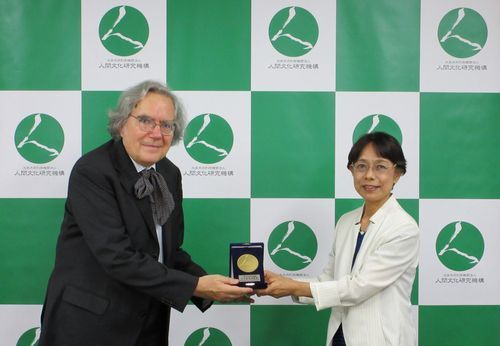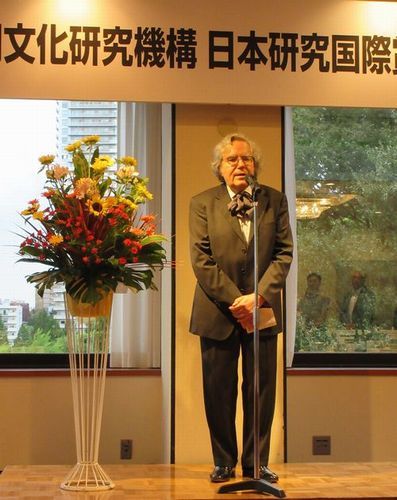Interview with Dr. Jean-Noël Robert, the Third Winner of the NIHU International Prize in Japanese Studies

Interview with the Collège de France Professor Jean-Noël Robert
Dr. Jean-Noël Robert, professor emeritus at the Collège de France, is a scholar of remarkable achievements in the field of Japanese Buddhism, particularly relating to the Tendai school. He has also been working on the comparison of vernacular Japanese (zokugo) with classical Chinese (seigo)— the language through which Buddhist doctrine was brought to Japan—using the concepts of hieroglossia and heteroglossia. He has expanded his research beyond Japan into many different areas of the Eurasian continent.
In recognition of these accomplishments, Dr. Robert was awarded the third National Institutes for the Humanities (NIHU) International Prize in Japanese Studies in 2021. In this interview, we asked Dr. Robert about what attracted him to Japan, the background and prospects of his research on hieroglossia, and the fields of Japanese studies that are trending in France, among other subjects.

Presentation of the NIHU International Prize in Japanese Studies. (Dr. Robert, left, and NIHU President KIBE, right)
What are the attractions of Japan to you?
An eminent French historian René Grousset (1885–1952) characterized Japan, particularly Nara, as the endpoint of the Silk Road. This description concisely captures what I find appealing about Japan. Buddhism was the conduit for the cultures of China, Korea, and India to gradually reach Japan. I believe that retracing this route from Japan through linguistic studies could illuminate the culture and history of East and Southeast Asia.
A similar idea can be found in Shutsujō Gōgo (1745) emerging from Meditation critique on Buddhism by scholar Tominaga Nakamoto (1715−1746). In his work, Tominaga very briefly pondered the potential outcome of spreading Japanese thought to Western countries (Saiiki) (i.e., reversing the path through which Buddhist traditions found their way into Japan). For me, one of the attractions of Japanese culture and civilization is its independent, distinct, and original value, as well as its expansive nature that links with Central and West Asian regions as well as India.
How did you develop the hieroglossia concept?
I was initially torn between studying Chinese and Japanese. But my mentor Bernard Frank (1927–1996), a scholar of Japanese religion and literature who taught at the École Pratique des Hautes Études, inspired me to choose Japanese as it encompassed both Chinese and Japanese writing.
Many believe the classical Chinese and Japanese cultural components of the Japanese language have existed independently, as a sort of dual system. However, my understanding is that the Japanese part of the language took shape gradually under the profound influence of Chinese.
Unlike the Nihon Shoki (Chronicles of Japan), the Kojiki (Records of Ancient Matters), Japan’s oldest narrative dating from 712, was compiled with a Japan-oriented mindset and is linguistically distinct from classical Chinese. For instance, the Japanese poetry featured in the Kojiki and the Nihon Shoki is not written in classical Chinese, but instead in a precursor of hiragana script that utilizes Chinese characters phonetically. Furthermore, the names of the deities and mythical locations (e.g., Toyoashihara no mizuho no kuni [lit. the land of abundant reed plains and rice fields]) in the narrative are all yamato kotoba (i.e., Japanese, as opposed to classical Chinese or loan words). In essence, these factors clearly indicate how Japanese-style verses and mythology were considered to be linguistically independent from the culture of mainland China.
Another reason why Japanese poetry is important is its potential for reflecting Buddhist teachings, as demonstrated in shakkyō-ka; adaptations of Buddhist doctrines in a verse format. The writings of Jien (1155−1225), a Tendai sect priest, are examples dating from around 1200. Jien claimed Japanese writing was superior to Chinese, citing its similarity to Sanskrit and arguing an equivalence between Japan’s kana writing system and Sanskrit characters. This idea evolved into the waka-soku-darani theory, which claims that Japanese poetry and Sanskrit dharani (mantras) hold similar religious authority. This is actually the inspiration behind the relative concept of hieroglossia. In addition to proposing that there is no single “sacred tongue” and that, rather, both “sacred” and vernacular languages coexist in a certain cultural sphere, the concept examines how the two languages develop to each other.
What are the themes you plan to pursue via the hieroglossia concept?
One possible theme is to explore the role of Old Church Slavonic in Europe, starting from a very unlikely example. In the Cathedral of Reims in eastern France has been kept for centuries an exquisitely decorated codex called an evangeliary, that is a collection of Gospel excerpts, not only translated into Old Church Slavonic, an ancient liturgical language of Slavic Europe, but written both in Cyrillic and Glagolitic scripts, which are now so to say antagonistic, the former being used in Orthodox countries, the latter now confined to Croatia, a Catholic Slavic country. Sources indicate that this evangeliary was used at the coronation of Louis XIV (r.1648-1715), suggesting a substantial connection between the French crown and the union of both Slavonic traditions as a symbol of a third sacred language after Latin and Greek. I hope to examine the symbolic, that is the hieroglossic process which brought about this very bizarre phenomenon now attracting more and more historians’ attention.

Dr. Robert gave a speech at an event commemorating the third NIHU International Prize in Japanese Studies.
Challenges in researching under the COVID-19
The COVID-19 pandemic prevented me from visiting Japan for a while, confining me to France. I grew concerned that studying the Japanese classics in my home country would lead me to think of it as some kind of fantasy world. This made me think of the scholars from the nineteenth to twentieth centuries, who were outstanding Japanologists despite never having visited Japan. One example is Arthur Waley (1889−1966), a British sinologist and translator of the Genji Monogatari (Tale of Genji). For him, his translation work may have entailed studying and researching subjects that are entirely disconnected from the reality surrounding him in the UK. But for me, a few hours spent searching for resources in Japan’s bookstores equate to a month’s worth of study if I were in France—which shows how critical it is for me to physically be in Japan for my research.
What areas of Japanese studies are trending in France now?
Gender and discrimination are evidently new themes emerging in Japanese studies. From this point of view, I am absolutely fascinated by the potentialities offered by Heian feminine literature in that field. I think that nowhere in world literature has existed such a cluster of creativity concentrated in the hands of such brilliant authoresses, with of course Murasaki-shikibu and the Genji-monogatari as the apex of Japanese letters for the centuries to come. And this novel is a perfect example of what I mean by hieroglossia: the substance of Chinese and Buddhist learning beautifully integrated into a Japanese text totally original in its outward appearance. It tells something that you have now more than ten Chinese versions of the Genji, and it is not at all the same thing to translate that novel into Chinese as, say, into French or English. The relationship between both texts is much deeper, because in some way it is a retroversion.
Manga, too, is very popular in France now. Japanese comic books are a good foundation for fostering or developing interest in Japan, but I hope people will go further. For example, manga, anime, and video games feature complex names of Japanese deities—which reminds me of a certain French person with an interest in video games and manga, who went on to publish a dictionary of Japanese mythology. The study of classical Japanese literature can benefit from unexpected fields and new perspectives, and if this cycle proves to be successful, it could produce good results.
What advice would you give to young scholars and students engaged in Japanese studies?
I think it is a terrible mistake to engage in Japanese studies without considering the broader East Asian cultural area. While most linguists would not study Japanese language history without knowledge of Chinese and Korean, even students who aim at classical Japanese literature do not feel the necessity to learn kanbun. I would strongly suggest that it is more rewarding, and much more fun too, to study even modern Japan culture within the frame of East Asia and to compare how China, Korea or Vietnam react to the impact of Westernization.
(Interviewer: OHBA Go, Researcher, Center for Innovative Research, National Institutes for the Humanities)
